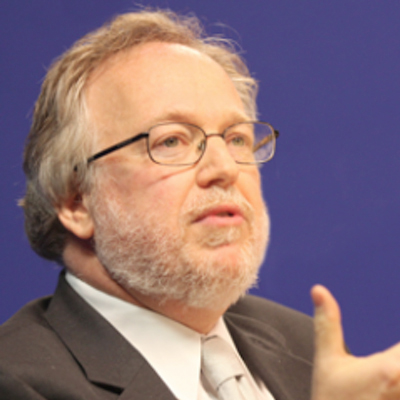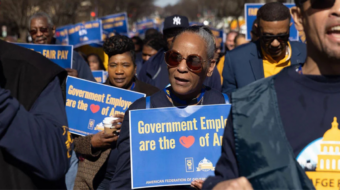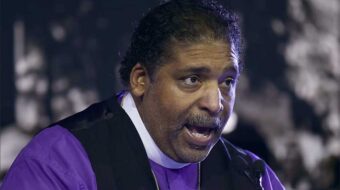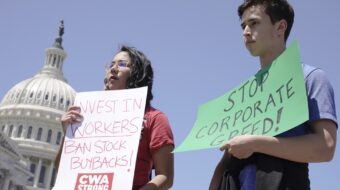
WASHINGTON – In time for Labor Day, Larry Rubin of the People’s World interviewed Lawrence Mishel, president of the Economic Policy Institute (EPI), the premier think tank focusing on the economic condition of low- and middle-income American familes.
People’s World: Why was EPI created?
Lawrence Mishel: We were founded in 1986 to fill a vacuum in economic research. From the beginning, we have been developing ways to articulate economic perspectives that address how we as a nation can create better ways to build shared prosperity.
P.W.: Is EPI research being used?
L.M.: Our studies are becoming more and more prominent in the national political discourse. Bernie Sanders and Hillary Clinton both often quote our findings, especially regarding wage stagnation, growing wage inequality, and the growing divergence between worker productivity and wages.
Republican candidates have been mentioning our findings, too.
We just released our latest findings on the income families in 600 different locations must earn to live a modest but adequate life style. This research is often used in collective bargaining by unions and by people in communities considering living wage ordinances.
P.W.: Why are the findings of EPI becoming more prominent?
L.M.: We’ve built a reputation for research that’s accurate and relevant.
P.W.: Talk about wage stagnation and growing wage inequality.
L.M.: CEOs are making almost 300 times what workers make. Our report on CEO pay shows that CEOs of the 350 largest firms earned an average of $15.2 million in 2013, up 937 percent since 1978.
On the other hand, a newly released Bureau of Labor Statistics research paper by Kristen Monaco and Brooks Pierce shows that from 2007 to 2014 hourly compensation was stagnant or fell for the bottom eighty percent of the workforce. The typical worker’s wages and compensation (wages and benefits, but excluding payroll taxes) declined respectively by 4 percent and 1.9 percent.
P.W.: What is the “divergence between worker productivity and wages?”
L.M.: For decades following the end of World War II, inflation-adjusted hourly compensation for the vast majority of American workers rose in line with increases in economy-wide productivity. However, even though net productivity grew 72.2 percent between 1973 and 2014, hourly compensation for the typical worker rose just 8.7 percent, or 0.20 percent annually, adjusted for inflation.
Since 2000, the gap between productivity and pay has risen even faster. The net productivity growth of 21.6 percent from 2000 to 2014 yielded just a 1.8 percent rise in inflation-adjusted compensation for the typical worker.
P.W.: Who is benefiting from the rise in productivity?
L.M.: Productivity growth that did not accrue to typical workers’ pay boosted incomes accruing to owners of capital and those concentrated at the very top of the pay scale (in inflated CEO and financial sector pay, for example). Since 2000, more than 80 percent of the divergence between a typical worker’s pay growth and overall net productivity growth has been driven by a falling share of income going to workers relative to capital owners and by growing compensation inequality. Over the entire 1973-2014 period, rising inequality explains over two-thirds of the productivity/pay divergence.
P.W.: So, an answer to pay inequality is … ?
L.M.: If the hourly pay of typical American workers had kept pace with productivity growth since the 1970s, there would have been no rise in income inequality during that period.
Policies to spur widespread wage growth must not only encourage productivity growth (via full employment, education, innovation, and public investment) but should also restore the link between growing productivity and the typical worker’s pay.
Unions can play a key role in doing this. The single largest factor that eroded middle class wages has been the erosion of collective bargaining. I don’t think we’ll ever obtain robust wage growth or a vibrant democracy unless we rebuild the labor movement.
P.W.: How would shrinking the wage gap impact the economy as a whole?
L.M.: It would help in the effort to build an economy based on people spending money they have earned, instead of an economy based on stock and housing asset bubbles and debt.
The purpose of our economy should be to help the vast majority of people improve their living standards.
Conservatives argue that we need more income inequality to grow our economy. We’ve tried that for the past 40 years and we know that does not work.
P.W.: What is your message for this Labor Day?
L.M.: There is nothing inevitable about income inequality or wage stagnation. It is the direct result of public policy choices on behalf of those with the most power and wealth, policy choices that have suppressed wage growth for the vast majority in recent decades.
Because wage stagnation was caused by policy, it can be alleviated by policy.
We can use our democratic processes to build an economy that works for the majority of people.
Photo: Lawrence Mishel, president of the Economic Policy Institute.










